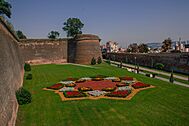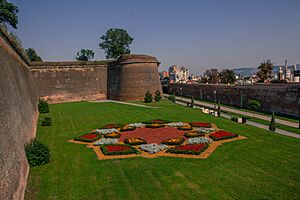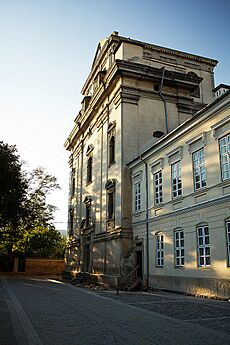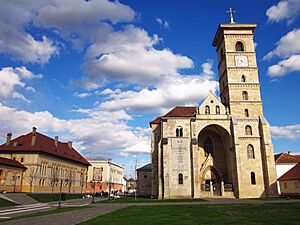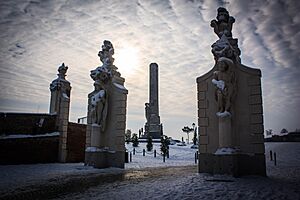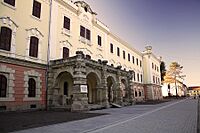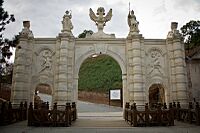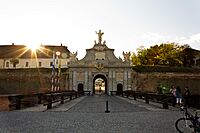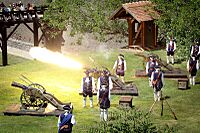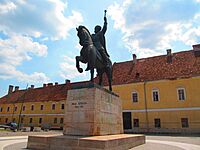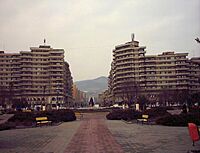Alba Iulia facts for kids
Quick facts for kids
Alba Iulia
|
|||||
|---|---|---|---|---|---|
|
Alba Carolina Citadel
Porta Principalis Dextra
Defense wall of the citadel
The Union Museum
Saint Michael Catholic Cathedral
|
|||||
|
|||||
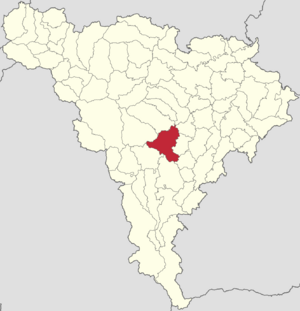
Location in Alba County
|
|||||
| Country | |||||
| County | Alba | ||||
| Area | |||||
| • Total | 103.65 km2 (40.02 sq mi) | ||||
| Population
(2021-12-01)
|
|||||
| • Total | 64,227 | ||||
| • Density | 619.65/km2 (1,604.89/sq mi) | ||||
| Time zone | UTC+2 (EET) | ||||
| • Summer (DST) | UTC+3 (EEST) | ||||
Alba Iulia is an important city in west-central Romania. It is the main city of Alba County. You can find it on the Mureș River in the historical region of Transylvania. About 64,000 people live there.
This city has a long and exciting history. It was once a Roman camp called Apulum. For many centuries, it was the center of the Roman Catholic Church in Transylvania. From 1526 to 1711, it was even the capital of the Principality of Transylvania.
Alba Iulia is very important to Romanians, Hungarians, and Transylvanian Saxons. On December 1, 1918, a big event happened here. The Union of Transylvania with Romania was declared. This led to the creation of modern Romania. Because of this, Alba Iulia is called the "Capital of the Great Union of Romania".
The city also includes four smaller villages: Bărăbanț, Micești, Oarda, and Pâclișa.
Contents
What's in a Name?
Exploring Alba Iulia's Many Names
In ancient Roman times, this place was called Apulum. This name came from the Dacian word Apoulon.
Later, in the 9th to 11th centuries, people called it Bălgrad. This Slavic name means "white castle" or "white town". The old Romanian name for the town was also Bălgrad.
The Hungarian name is Gyulafehérvár. This means "white castle of the Gyula". The "Gyula" was a Hungarian warlord named Gyula II. He was baptized around 950.
The name Alba means "white" in Romanian. Iulia comes from "Julius", referring to Gyula II. So, Alba Iulia means "White Julius". This modern Romanian name became popular in the 18th century. It became official when the city joined Romania.
The German name in the 16th century was Weyssenburg. Later, the Saxons changed it to Karlsburg. This was to honor Charles VI, Holy Roman Emperor. In Jewish languages like Yiddish and Hebrew, Karlsburg was also used.
Over the centuries, the city had many names. These names show its rich history and the different cultures that lived there.
A Journey Through Time: Alba Iulia's History
Ancient Roman Beginnings
The city of Alba Iulia is built near an ancient Dacian center called Apulon. After the Roman Empire took over Dacia, this area became very important. It was named Apulum.
Apulum was the biggest city in Roman Dacia. It was home to the XIII Gemina Roman Legion. The Roman camp, or castrum, here is the largest in Romania. It covered a huge area, about 37.5 hectares (92.7 acres).
Medieval Times and Important Leaders
Around the 10th century, a Hungarian leader named Gyula built the capital of his dukedom here. He was baptized in the Byzantine Empire. Around 950, he built the first church in Transylvania in Alba Iulia.
Later, the first Catholic cathedral was built here. The current Catholic cathedral was built in the 12th or 13th century. In 1442, John Hunyadi, a famous leader, used the citadel. He prepared for a big battle against the Ottoman Turks here. He was buried in the cathedral after he died.
Ottoman and Habsburg Rule
In 1542, Alba Iulia became the capital of Transylvania. It stayed the capital until 1690. During the time of Prince Gábor Bethlen, the city became a center for culture. An academy was even started here.
On November 29, 1599, Michael the Brave entered Alba Iulia. He was the leader of Wallachia. He became the leader of Transylvania after winning a battle. In 1600, he also took control of Moldavia. This united the three main Romanian lands for a short time.
Alba Iulia became part of the Habsburg Empire in 1690. The famous Alba Carolina fortress was built between 1716 and 1735. It was designed by Giovanni Morando Visconti. The leaders of a peasant uprising were executed here in 1785. Important things like the Batthyaneum Library (1780) and the railway (19th century) also came to the city.
Modern Era: Union and Coronations
At the end of World War I, something very important happened. On December 1, 1918, Romanian leaders gathered in Alba Iulia. They declared the Union of Transylvania with Romania. This was a huge step towards forming modern Romania.
In 1922, Ferdinand I of Romania was crowned King of Romania in Alba Iulia. His wife, Queen Marie, was also crowned here. This was a symbolic event for the newly united country.
Jewish Community History
The Jewish community in Alba Iulia was the first in Transylvania. It started in the 14th century. In 1623, Prince Gabriel Bethlen officially allowed a community to be founded.
From 1754 to 1868, the town's rabbi was the chief rabbi for all of Transylvania. A synagogue was built in 1840. Many local Jews worked in growing grapes for wine. Later, they became artisans. By 1930, about 13% of the town's population was Jewish.
During World War II, the Jewish community faced difficulties. After the war, many Jews moved away.
Weather in Alba Iulia
Alba Iulia has a climate with warm summers and cold winters. This is called a humid continental climate.
| Climate data for Alba Iulia (coordinates:46°03′N 23°33′E / 46.050°N 23.550°E, elevation: 246 masl.) | |||||||||||||
|---|---|---|---|---|---|---|---|---|---|---|---|---|---|
| Month | Jan | Feb | Mar | Apr | May | Jun | Jul | Aug | Sep | Oct | Nov | Dec | Year |
| Mean daily maximum °C (°F) | 3.2 (37.8) |
7.9 (46.2) |
12.8 (55.0) |
18.2 (64.8) |
22.6 (72.7) |
27.3 (81.1) |
29.4 (84.9) |
30.1 (86.2) |
24.9 (76.8) |
18.3 (64.9) |
10.4 (50.7) |
5.2 (41.4) |
17.5 (63.5) |
| Daily mean °C (°F) | −0.1 (31.8) |
3.4 (38.1) |
7.1 (44.8) |
11.8 (53.2) |
16.6 (61.9) |
21.1 (70.0) |
22.6 (72.7) |
23.0 (73.4) |
18.3 (64.9) |
12.3 (54.1) |
6.5 (43.7) |
2.4 (36.3) |
12.1 (53.7) |
| Mean daily minimum °C (°F) | −3.5 (25.7) |
−1.0 (30.2) |
1.4 (34.5) |
5.3 (41.5) |
10.5 (50.9) |
14.9 (58.8) |
15.9 (60.6) |
15.9 (60.6) |
11.8 (53.2) |
6.3 (43.3) |
2.7 (36.9) |
−0.4 (31.3) |
6.7 (44.0) |
| Average precipitation mm (inches) | 25.4 (1.00) |
25.0 (0.98) |
32.7 (1.29) |
37.5 (1.48) |
79.0 (3.11) |
106.1 (4.18) |
70.7 (2.78) |
49.9 (1.96) |
42.5 (1.67) |
34.7 (1.37) |
39.3 (1.55) |
30.1 (1.19) |
572.9 (22.56) |
| Average precipitation days (≥ 0.1 mm) | 12.7 | 11.4 | 11 | 10.4 | 15.8 | 13.6 | 11.3 | 8.4 | 9.2 | 9.2 | 12.9 | 11.9 | 137.8 |
| Average snowy days | 6.2 | 2.3 | 2.1 | 0.6 | 0 | 0 | 0 | 0 | 0 | 0 | 1.2 | 3.2 | 15.6 |
| Source: Meteomanz (2014-2023) | |||||||||||||
Must-See Landmarks
Exploring the Alba Carolina Fortress
The most historic part of Alba Iulia is the Upper Town. This area was developed by Charles VI, Holy Roman Emperor. The amazing Alba Carolina fortress was built here. It has seven bastions and is shaped like a star. It was built between 1716 and 1735. This fortress is a great example of a baroque fortress.
Inside the fortress, you'll find many important buildings:
- The Union Hall
- The National History Museum of Unification
- The Princely Palace
- The Orthodox Cathedral
- The Roman Catholic Cathedral
- The Batthyaneum Library
- The University of Alba Iulia
The Roman Catholic Cathedral was built in the 10th and 11th centuries. It's a key example of medieval Romanic style in Transylvania. The tombs of John Hunyadi and Queen Isabella Jagiełło are here.
Famous Buildings and Their Stories
The Batthyaneum Library is in a beautiful old church. In 1780, Bishop Ignác Batthyány turned it into a library. It has many old manuscripts and rare books. These include parts of the 9th-century Codex Aureus of Lorsch. The first astronomy observatory in Transylvania was also here in 1792.
The Apor Palace is on the same street. It was built in the 17th century. It was once the home of Prince Apor. Later, it was used by an Austrian army leader.
The Orthodox Unification Cathedral was built between 1921 and 1923. Its frescoes were painted in a traditional style. King Ferdinand I and Queen Marie were crowned here in 1922. This was a very special event for Romania.
The National Museum of Unification is in the "Babylon" Building. It was built for military use in the 1850s. It became a museum in 1887. The museum has over 130,000 historical items. The Union Hall is also part of this museum. On December 1, 1918, Romanian leaders met here. They decided to unite Transylvania with the Kingdom of Romania.
The Princely Palace was the home of Michael the Brave in 1600. This was when he briefly united the Romanian lands. Old writings describe it as a very fancy building. After 1716, it became a barracks for the Austrian army.
Sister Cities Around the World
Alba Iulia is twinned with these cities:
 Aigio, Greece
Aigio, Greece Alcalá de Henares, Spain
Alcalá de Henares, Spain Alessandria, Italy
Alessandria, Italy Arnsberg, Germany
Arnsberg, Germany Biograd na Moru, Croatia
Biograd na Moru, Croatia Cetinje, Montenegro
Cetinje, Montenegro Chișinău, Moldova
Chișinău, Moldova Düzce, Turkey
Düzce, Turkey Lanzhou, China
Lanzhou, China Nof HaGalil, Israel
Nof HaGalil, Israel
 Sliven, Bulgaria
Sliven, Bulgaria Székesfehérvár, Hungary
Székesfehérvár, Hungary Varese, Italy
Varese, Italy Viadana, Italy
Viadana, Italy
People of Alba Iulia
| Historical population | ||
|---|---|---|
| Year | Pop. | ±% |
| 1850 | 5,408 | — |
| 1880 | 7,338 | +35.7% |
| 1890 | 8,167 | +11.3% |
| 1900 | 11,507 | +40.9% |
| 1912 | 11,616 | +0.9% |
| 1930 | 12,282 | +5.7% |
| 1948 | 14,420 | +17.4% |
| 1956 | 14,776 | +2.5% |
| 1966 | 22,215 | +50.3% |
| 1977 | 41,199 | +85.5% |
| 1992 | 71,168 | +72.7% |
| 2002 | 66,369 | −6.7% |
| 2011 | 63,536 | −4.3% |
| 2021 | 64,227 | +1.1% |
| Source: Census data | ||
According to the 2021 census, Alba Iulia has 64,227 people. In 2011, there were 63,536 residents. Most people living here are Romanians (95.3%). There are also groups of Romani (3.2%), Hungarians (1.9%), and Germans (0.2%).
Panoramas
Image gallery
See Also
 In Spanish: Alba Iulia para niños
In Spanish: Alba Iulia para niños




